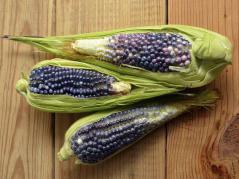Activists have convinced the public that "natural" is better, but studies show that isn't really true. Malaria is certainly not healthy and natural banana flavor can be more toxic than the synthetic kind, according to the American Council on Science and Health.
But that's marketing. If people want natural dyes, they are going to pay a lot more. But a University of Illinois project wants to fill the gap with colored corn. And science. You can certainly get natural colors with wine skins, red carrots, and beets, but it's a terrific waste of food and money. And as Starbucks discovered, customers don't want all-natural bugs that produce some colors, even if it has been done since the 15th century, long before Frappuccinos existed.
 Credit: University of Illinois
Credit: University of Illinois
By experimenting with purple and blue corn varieties the economics may be solved. The pigments known as anthocyanins are located in the outer layers of the corn kernel, meaning the rest of the corn can still be used. And because the corn varieties were genetically modified before the 1990s, activists won't object. The team behind the project identified the optimal milling process and demonstrated that corn-derived anthocyanins remain stable in food products. In a recent study, they looked at anthocyanin type and concentration in nearly 400 genetically distinct lines of colored corn. They grew these lines in Illinois to see if anthocyanin concentration stayed constant from generation to generation - a critical quality for breeding new varieties.
Peruvian types had some of the highest anthocyanin concentrations, and they held up throughout multiple generations, so they can select for the trait of interest without worrying whether it will be expressed in new environments. The next step will be getting those Peruvian genes into high-yielding corn hybrids selected for production in the Midwest.